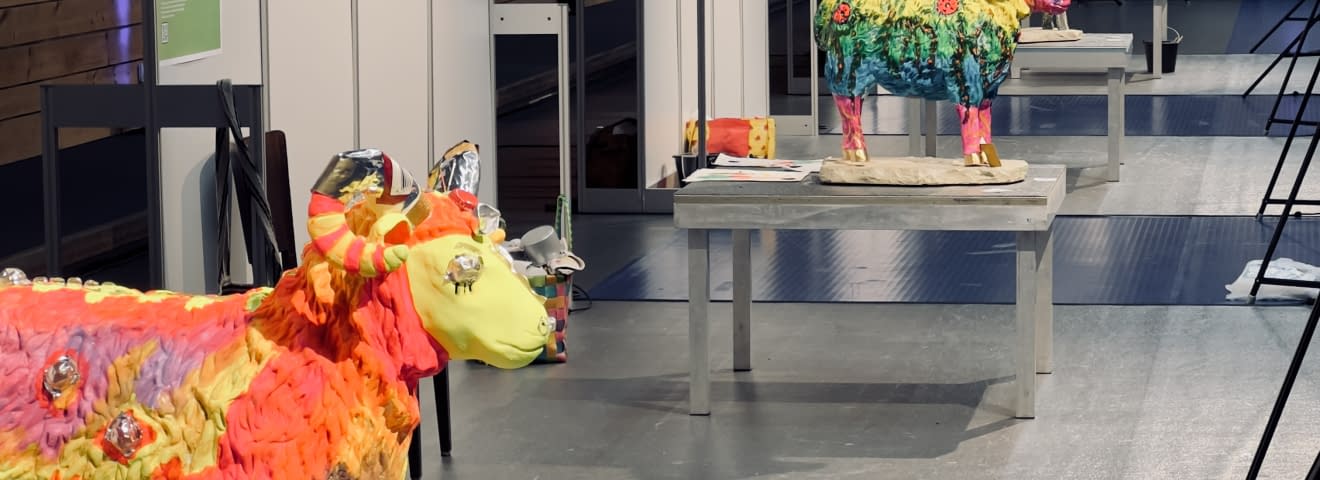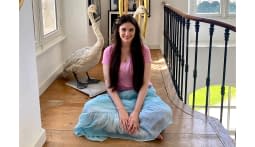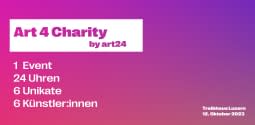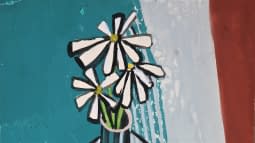Art 4 Charity or the Transformation of the Rams
As different as their work methods and techniques may be, the challenge is the same for all of the 9 artists. Normally, they work with brushes, paints or photographic transfer prints on a flat surface. Now, 9 three-dimensional ram sculptures with fur texture and rippled horns challenge seven female and two male artists. From hour to hour, nervousness and tension diminish, the atmosphere becomes increasingly relaxed, casual, cheerful. The pop-up studio in Lucerne's Swiss Life Arena, organised by art24 for the event, gradually loses its plainness. After more than 5 hours, the curling hall is charmingly conquered by the concentrated artists with their imaginative, elegant as well as poppy and colourful, golden shining creations. The 9 rams reflect 9 individual artist personalities who remained authentic in their motives, technique and execution.
Viktoria Koestler loves castles, their sense of nostalgia and flair. Her «Golden Power Ram», which could easily be a luxurious castle object, appears in an elegant, discreet outfit of black-grey dashed lines on the fur which is left white and with radiant 24 carat gold leaf horns. The fact that glamour and elegance with an eccentric-cheeky touch go well together is shown by the single red hoof. It stands for Viktoria's logo «RedOutsite», which always marks the outer edges of her paintings in striking red. In the «Golden Power Ram» Viktoria realises her idea of a «valuable appearing object, which at the same time reflects the assertiveness and resilience of the ram in the gold, but also the hope for future motivation».
Margot Ressel first covers her ram with a camouflage-like pattern in her own mixture of dark olive, lemon yellow and white. This neutral, mud-coloured base invites further colour effects and contrasts: «I enjoy colours and flowers, the areas that still remain white call for cheeky colour contrasts». And these also come in further steps: Margot reaches for light blue, violet, pink and orange colours and lets the animal shine in a splendidly bright dress of blossoms and flowers. «I'm happy it turned out the way it did. I really like painting with colours and happiness, colourfulness as well as the friendly face are important to me». And she spontaneously describes her object «The friendly-coloured ram».
Guido Parpan smiles – even 30 minutes later his ram with the philosophical name «Time to live» is apparently still white. «That's the primer. You must think I haven't done anything yet? » A little later it is clear in which direction this is going: Guido gradually covers the face and horns with extremely thin, real gold leaves, fixes them with a brush, then reaches for thin sheets of precious metals in bronze, silver and copper and coats the rest of the animal's body with them. Metallic, shiny acrylic colours complete the dazzling design. In the end, the ram glows magnificently in the spotlight, reflecting the surroundings and the light in an oscillating and sparkling way. «For me, gold is the rising, the awakening, the ‚Zeit zu leben‘».
Hanna Mare is inspired by the ram with golden fur from the Greek mythology as well as the golden calf, which stands as a metaphor for wealth, greed for power as well as moral and ethical degeneration. Indirectly, it also refers to the sky, the stars and the sign of the zodiac. These associations lead to a blue-painted head, golden ears and horn tips, complemented by the golden-blue colour mixture poured over the back and pigments sprinkled on top. This random working method, typical of Hanna, results in wonderful, uncontrolled colour gradients and streaks that go their «own way» across the back and over the plinth. Like a sign of strength, with which «The Golden Ram» allows power and greed to melt away.
Jean Ravel picks up markers, starts on the ram's side with the unmistakeable message «Love» and adds inch by inch smiling suns, clouds and faces, cats, bears, smileys and hearts in the manner of pop art. «My ideas come spontaneously, which I realize accordingly. One thing emerges from the other in the manner of doodles. This makes me happy and free». Jean continues his work unperturbed, reaching for the next marker, drawing amusing, cheeky, pop-art motifs that gradually come together to form a comic-like story. «I work childlike, unselfconsciously and not perfect. Humour is always important to me and with the object I spread a good mood». Lady «Loveram» gracefully shows this with her pumps, long eyelashes and kissing mouth.
Verena Kandler collects waste packaging. They should be as golden, transparent and glittering as possible in order to appear valuable. By integrating them into her artworks, Verena enhances the value of the waste on the one hand and the extravagantly shimmering object on the other hand. Her «Recycle Ram» shines in a colour mixture of ruby, orange, pink and yellow, which adapts wonderfully to the fur structure. The cheerful yellow face, the eyes, horns and spine, accentuated with pieces of waste and appearing as if they are gold-plated or made of glass, give the luminous ram a unique radiance. No one thinks of tablet packaging, wrappings, or waste anymore. «I transform my works, give them a glamorous look and the rubbish is given a new function».
Maria Fernanda Schulz applies intense bright colours of blue, green and yellow in wide ribbons on the ram's body. «I love these colours of my Colombian-Caribbean origin», which symbolise the sea, plants growing upwards and the light. The head in a pink-purple mix represents «life, energy and optimism», while the golden horns and hooves reflect preciousness. Indigenous and Colombian symbols, sunflowers, blossom tendrils as well as circle and spiral ornaments in the animal face underline Maria Fernanda's vibrant, energised, optimistic-positive colourfulness, reaffirmed by the swimmer who «in the river of life» strives towards the sun symbol with her arms outstretched. «Melcocha» is pure joy!
Helen Eggenschwiler measures, cuts, and spans the sculpture with variously sized pieces of fabric, fitting the head and body, and then fixes each cut-out piece of fabric with hot glue. Her «Growing, never to stop» ram is given a custom-made landscape dress with tree and leaf motifs. Helen, who does not work with brushes and paints but with a special transfer printing process of her own photos, for example on garden fleece, remains true to her working method and choice of motifs also in this work: «Nature and landscape are always a theme of mine». Here it is the Lucerne forest «Gütschwald» with its trees growing towards the sky that is superimposed on the ram as a realistic topic, turning it into a surreal, «clothed» forest animal.
Judit Flamich moves around the ram, sometimes in dancing steps, sometimes standing on the top of the table, and from this special perspective paints «Halus», a mythological animal that embodies sacrifices for the prosperity of a society. Across the ram's back she spreads motifs from Lucerne such as Mount Pilatus, the Kappel Bridge, church towers and the water tower, which are partly reflected in the blue Reuss river. It is exciting how she harmonises the fur structure with the movement of the painted water and its gently rippling waves, allowing them to collaborate with each other. «I'm a passionate painter», Judit confesses, giving her otherwise white creature only a hint of a face with bright yellow horns and curled tips, which underlines the mystical aura.







